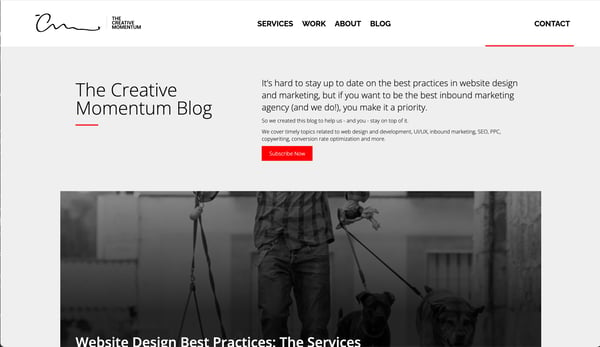
Did you know there are currently more than 600 million active blogs around the world? This can sound like an intimidating space to build a name for your brand, but it’s a necessary challenge to undertake. Why? Websites with blogs perform better in search queries, build brand authority, attract more customers, and drive more sales.
So, what is the best way to create a business blog that ranks well and turns site visitors into paying customers? Start with this guide on best practices for creating a company blog.
Why Every Business Needs an Active Blog
Businesses in any industry can benefit from an managing an active blog. The key to success in business blogging comes down to finding the right niche, and writing high-qualiity and highly-relevant content that provides value to that niche. This helps ensure that you attract organic traffic, build a following and eventually rise up as an authority in your industry. Here are biggest reasons for creating a business blog.
Your Competitors’ Already Have Blogs
No matter how small your business is and how specialized the niche, chances are that you also compete with at least one Fortune 500 company. According to Hubspot, of the top 200 Fortune 500 companies, roughly 50% of them had corporate blogs by 2018. Small businesses have also ventured into the blogging space. This puts additional pressure on businesses of all sizes to start blogging.
Blogging Can Generate Revenue
Corporate blogs are primarily motivated by the prospect of converting a certain percentage of their readers; they know that if they focus on creating great content, some visitors will become more familiar with their brand, develop trust in their authority and eventually convert.
Corporate blogs can also generate income with the right partnerships, and blogs with large readership bases can get money from affiliate links and ads. In 2018, the Huffington Post blog earned a monthly income of $14 million.
Blogging Improves SEO
No matter what your search engine strategy is, if SEO is a top priority, you need a blog. Hubspot estimates that blogging leads to a 97% increase in indexed links. It also leads to a 434% increase in how many pages Google indexes for its search engine. This increases your website’s ability to attract organic traffic and generate high-quality leads. In fact, companies with blogs see a 67% increase in lead generation over their competitors without blogs.
Provides Content for Repurposing
Blogs are a great central point for content. Thereafter, you can repurpose blogs to create other types of content. Here are just a few examples of other types of content that can be inspired by or repurposed from a blog's content:
- Social media posts
- Videos or podcasts
- Eye-catching infographics or slideshows
Check out other common pages in our Website Design Best Practices series!
Website Design Best Practices: How to Create the Best Homepage
Website Design Best Practices: How to Create the About Us Page
Website Design Best Practices: How to Create the Services Page
Website Design Best Practices: How to Create a Resources Page
Website Design Best Practices: How to Create a Pricing Page
Website Design Best Practices: How to Create a Contact Page
How to Structure a Blog on Your Website

Reading is at risk in America and has been on a steady decline for several decades. According to The Washington Post, Americans read leisurely for only 17 minutes per day in 2017. Compare this with 23 minutes per day in 2004. Keep these statistics in mind while creating your business blog strategy.
Choose a SEO-Friendly Title (that Isn't Clickbait)
An engaging, relevant title can do wonders to stop persons scrolling through social media links or searching for answers on Google. But, caution ahead: modern consumers avoid articles that look like clickbait. Clickbait titles can also negatively impact your credibility. Come up with great blog topics that answer popular search queries, address keywords your targeting or ranking for, and let the reader know exactly what to expect the title (you can use the title of this post as an example!)
Use Subheaders
After sinking a ton of time and emotional energy into crafting a perfect blog, we don't want to break your heart, but it's important to know that most people skim through blog posts rather than read the whole thing. Consequently, it’s important to organize the information using subheaders. These provide quite a few benefits for your readers:
- The subheaders break up large blocks of text into less-intimidating chunks of information, and ideally are valuable on their own.
- Strategically-placed subheaders make it easy to get a gist of the whole article.
- Readers can jump to the specific section they want to read in detail.
Add Graphics: Images, Videos, Charts, GIFs, etc.
No matter how well-organized your article is, if it’s all just text, you’ll have a more difficult time keeping readers on the page.
Start with a featured image that piques your readers’ interest. Then, strategically place relevant images and media throughout the blog post. Here are some examples of different graphics to help you break-up your blog content:
- Images
- Videos
- Graphs
- Polls
- Screenshots or screencasts demonstrating a concept
- GIFs
Organize Your Blog Topics Into Larger Categories
Over time, you'll build so much content that customers will need a way to find articles on specific topics. You can use these categories and tags to organize your articles. For example, a camera manufacturing company can divide its articles into tutorials, travel tips, and featured photos from customers.
What to Blog About for Your Business

One of the biggest hurdles is knowing what to blog about. In some cases, the topics can flow endlessly, only to run out within a few weeks. So, what should you be sharing on your blog? Here are some useful and common types of blogs to help you brainstorm.
How-To Blogs
Modern-day consumers might be reading less, but they are invested in learning new skills. You may have even heard people say, 'You can figure everything out online with a Google search." Well, this means your business blog can be a part of the DIY trend.
How-to blog posts that are very helpful for top-of-the-funnel prospects, and help funnel them to your business. The posts can include videos related to your products or service, numbered steps, and imagery to help illustrate concepts. An example of this type of blog post would be a company that sells pasta and pasta sauce sharing pasta recipes.
A "Listicle" Blog Featuring Helpful Tips
A listicle blog article is a combination of two words: list and article. A popular business blog best practice is to create these blogs featuring a list of tips related to their subject matter expertise. For example, consider a company that sells action cameras. This company is positioned to write both a blog giving advice on how to find the perfect skateboard or create a listicle blog article covering the top mountain-biking trails around the world.
Blog Covering the Latest Research
Has your company completed studies or have you discovered research that your readership base would be interested in reading and understanding? Sharing, summarizing, and paraphrasing this information builds credibility and followers. For example, a gynecologist might share research on HPV, its prevalence in the local community, and how to prevent it.
Dense research and text-heavy studies are begging to be broken down using simplified language, highlighting key points, and using eye-catching graphics. Thus, writing posts that cover the latest research in your business' field is a great strategy for company blogs.
Corporate Highlights Blog Post
Today's consumers are more interested in "who a company is" then ever before. Use this to your advantage by getting personal through your blog. Here are some ideas for creating a blog post that highlights what's been going on in your company:
- Are you about to open a second location for your business?
- Did you recently receive a prestigious grant?
- Has an employee received recognition in the community for volunteer work?
Blogs on Popular and Newsworthy Topics
If there is a popular topic in the news related to your industry, writing about it can significantly boost your SEO, and also builds your brand authority. This works even better if you can find a way to keep the content evergreen. Consider, for instance, a big soda company making a marketing blunder. A smoothie shop might write a blog post on five healthy alternatives to soda.
Still Stuck? We Can Help You with Your Company Blog
When creating a blog, one of the most important first steps is figuring out how it will look. You need a blog on your website that creates a professional space while ensuring creative freedom. The Creative Momentum can build a blog that complements your website. We can also completely redesign your website to include one. Contact us today to learn more about your options.


